Bing Qu’s paper suggesting a cost-effective way to prevent earthquake-induced building collapse was recently presented with the Moisseiff Award from the American Society of Civil Engineers (ASCE).
The paper, titled “Seismic Rehabilitation of Concentrically Braced Frames Using Stiff Rocking Cores,” was the culmination of a 4-year project, sponsored by the National Science Foundation. Published in the Journal of Structural Engineering, it was co-written by researchers from Case Western Reserve University and UC San Diego.
Bing is an associate professor in the Civil and Environmental Engineering Department.
A concentrically braced frame (CBF) is a structural system with diagonal braces as a means to resist wind and earthquakes. In these, both ends of the brace join at the end points of other framing members to form a vertical truss, creating a stiff frame.
According to Bing’s research, CBFs can exhibit a “soft-story” response, in which drift and damage are concentrated in a single story, whereas other stories remain relatively undamaged.
“The detrimental soft-story failure mechanism has been observed from building structures, particularly sub-standard framing, in past earthquakes in many countries,” Bing said.

The paper examines the behavior of CBFs and proposes a rehabilitative design procedure that uses a stiff rocking core to mitigate soft-story response. This technique uses a stiff, elastic “spine” to provide corrective lateral forces on CBFs to achieve the desired uniform drift responses.
That technology was developed, Bing said, to transform building frames – mostly pre-1990s – that were not designed with modern earthquake-mitigation features.
“The rocking core technology can be used for both new constructions as well as seismic rehabilitation and retrofit of existing systems,” Bing said.
Prevention of soft-story failure has been one of the most challenging research topics in the field, Bing said. And, according to his paper, the proposed research can lead to building rehabilitations that are both cost-effective and architecturally flexible.
The Moisseiff Award, established in 1947, was named after Leon S. Moisseiff, a notable contributor to the science and art of structural design. The prize is given once a year to an important paper published in a print issue of an ASCE journal.
Bing received the recognition in Orlando, Florida, last month at the annual ASCE Structures Congress.


